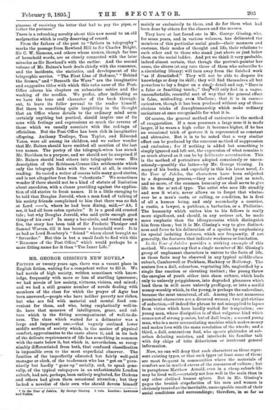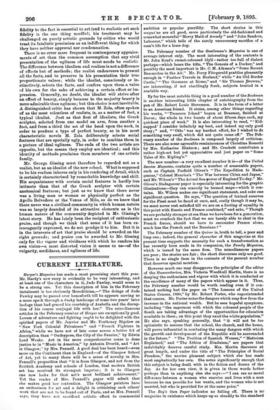MR. GEORGE GISSING'S NEW NOVEL.*
FIFTEEN or twenty years ago, there was a vacant place in English fiction, waiting for a competent writer to fill it. We had novels of high society, written sometimes with know- ledge, frequently with more or less of startling ignorance ; we had novels of low society, virtuous, vicious, and mixed ; and we had a still greater number of novels dealing with members of the class for which the prayer of Agar has been answered,—people who have neither poverty nor riches, but who are fed with material and mental food con- venient for them, and who, being emphatically well-to- do, have that measure of intelligence, grace, and cal- tare which is the fitting accompaniment of well-to-do- nese. The class which waited for a delineator was a large and important one,—that vaguely outlined lower middle section of society which, in the matter of physical comfort, approximates to the caste above it, and in its lack of the delicate requirements of life has something in common with the caste below it, but which is, nevertheless, so recog- nisably differentiated from both, that confused classification is impossible even to the most superficial observer. The families of the imperfectly educated but fairly well-paid manager or clerk, of the tradesman who has "got on" pecu- niarily but hardly "gone up" socially, and, to speak gene- rally, of the typical ratepayers in an unfashionable London suburb, had not, perhaps, been entirely neglected, for Dickens and others had given them occasional attention ; but they lacked a novelist of their own who should devote himself • Is the Year of Jubilee. By George Gigging. 3 vols. London: Lawrence and Sullen.
mainly or exclusively to them, and do for them what had been done by others for the classes and the masses.
They have at last found one in Mr. George Gissing, who. for some years, and in various volumes, has delineated the members of this particular social grade—their manners and customs, their modes of thought and life, their relations to each other and to those who stand just above or just below them on the social ladder. And yet we think it very probable, indeed almost certain, that though the portrait-painter has come, the sitters (at any rate those of them who subscribe to a circulating library) will tarn away from the finished work "as if dissatisfied." They will not be able to dispute its knowledge or deny its skill ; they will find themselves all but powerless to lay a finger on a single detail and say, "Here is a false or fumbling touch ; " they will only feel in a vague, uncomfortable, resentful sort of way that the general effect is false, misleading, evea libellous ; that it is in essence caricature, though it has been produced without any of those obvious tricks of draughtsmanship which make ordinary caricature at once recognisable for what it is.
Of course, the general method of caricature is the method of exaggeration. If a man possesses a large nose it is made larger, if he wears a high collar it becomes higher, if he has an occasional trick of gesture it is represented as constant and obtrusive. But it is to be noted that a very similar effect can be produced by the converse method of suppression and exclusion ; for if nothing is added but something is simply ignored and left out, the expression of what remains
as much altered as it can be by deliberate accentuation. This is the method of portraiture adopted consciously or uncon- sciously—possibly the latter—by Mr. George Gissing. In many of his books, and especially in this his latest novel, In the Year of Jubilee, the characters have been subjected to a depressing process,—they are allowed just as much, and no more, of the common humanity as shall serve to give life to the se'ectad type. The artist who sees life steadily and sees it °!e, never allows us to forget that whatso- ever be a man's caste, or calling, or condition, he is first of all a human being, and only secondarily a courtier, a rustic, a lawyer, a publican, a barbarian, or a Philistine. The humanity which unites him to his fellows is really more significant, and should, in any serious art, be made more emphatic than the idiosyncrasies which distinguish him from them ; but it is Mr. Gissing's way to give distinct- ness and force to his delineation of a species by emphasising its special isolating features, which are frequently, if not generally, the features that indicate weakness or limitation.
Ia the Year of Jubilee provides a striking example of this method. We cannot say that a single member of Mr. Gissing's group of unpleasant characters is untrue to the facts of life, as those facts may be observed in any typical middle.class suburb, Camberwell or Peckham, Hackney or Holloway. The seniors live a dull, colourless, vegetating life, nnglorified by a single fine emotion or elevating instinct ; the young throw the energies of youth either into sham culture, which leads only to unlovely priggishness, into degraded pleasures which land them in still more unlovely profligacy, or into a sordid money-worship which, in the young, is perhaps the anloveliest, because the most unnatural, of all. Among the not numerous prominent characters are a divorced woman ; two girl-victims of seduction,—if indeed the phrase be not misapplied to lapses from virtue which have hardly waited for temptation; one young man, whose dissipation is of that vulgarest kind which comes not of strong plosion, but of dull brain ; a second young man, who is a mere accumulating machine which makes money and makes love with the same revolution of the wheels; and a third, a dull, sententious fool, who spouts platitudes at sub-
urban debating societies, and interlards his familiar talk with dry chips of trite didacticism or irrelevant general information.
Now, no one will deny that such characters as these repre- sent existing types, or that such types (at least some of them)
are most fr€ quent in communities where the materials of comfort are in marked excess of the resources of culture ; but to paraphrase Matthew Arnold, even in a. cheap suburb life
may be lived well,—certainly not less well in the main than in
any other civilised human sphere. Bat in Mr. Gissing's pages the brutish stupefaction of his men and women is
obviously treated as the inevitable, unescapeable result of their social conditions and surroundings, therefore, in so far as
fidelity to the fact is essential to art (and to realistic art such fidelity is the one thing needful), his treatment may be challenged on purely artistic grounds by critics who would treat its fatalistic pessimism as an indifferent thing for which they have neither approval nor condemnation.
There is no error more frequent in contemporary appraise- ments of art than the common assumption that any vivid presentation of the ugliness of life must needs be realistic
The difference between idealism and realism is not a difference of effects but of methods ; the realist endeavours to present
all the facts, and to preserve in his presentation their true proportionate values; while the idealist, consciously or in- stinctively, selects the facts, and confers upon them a value of his own for the sake of achieving a certain effect or im- pression. Generally, no doubt, the idealist will strive after an effect of beauty, simply because to the majority beauty is more admirable than ugliness ; but this choice is not inevitable. A distinguished critic has shown that M. Zola, often spoken of as the most relentless of realists, is, as a matter of fact, a typical idealist. Just as that first of idealists, the Greek sculptor, selected from one model an arm, from another a foot, and from a third the set of the head upon the neck, in order to produce a type of perfect beauty, so in his most characteristic novels M. Zola deliberately selects social features that are specially ugly, in order to combine them in a picture of ideal ugliness. The ends of the two artists are opposite, but the means they employ are identical ; and this identity of methods proclaims them members of one artistic family.
Mr. George Gissing must therefore be regarded not as a realist, but as an idealist of the new school. What is supposed to be his realism inheres only in his rendering of detail, which is certainly characterised by remarkable knowledge and skill. His acquaintance with certain social features is hardly less intimate than that of the Greek sculptor with certain anatomical features ; but just as we know that there never was a living man or woman so physically perfect as the Apollo Belvedere or the Venus of Milo, so do we know that there never was a civilised community in which human nature was so largely denuded of its attractive elements as is the human nature of the community depicted in Mr. Gissing's latest story. He has lately been the recipient of enthusiastic praise, and though we think that some of it has been ex- travagantly expressed, we do not grudge it to him. But it is in the interests of art that praise should be awarded on the right grounds; and praise can be awarded to Mr. Gissing only for th3 vigour and vividness with which he renders his own vision—a most distorted vision it seems to us—of the vulgarity, sordidness, and ugliness of life.







































 Previous page
Previous page